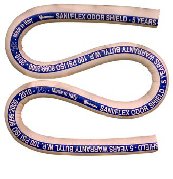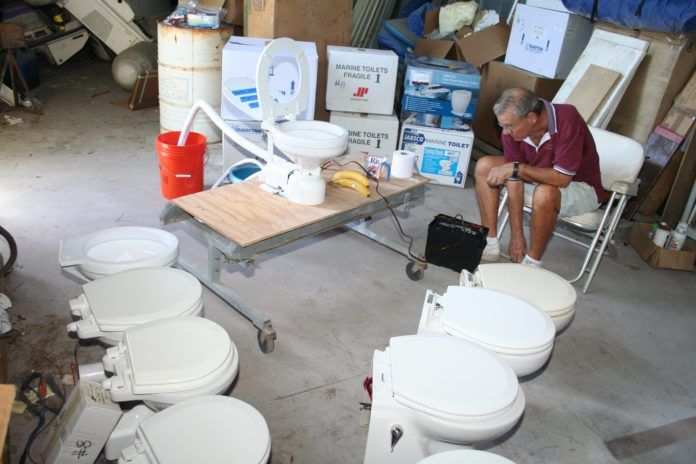It’s not often I get to see photos of an intact, but excruciatingly stinky holding tank get wedged and jimmied through cutouts in the boat’s interior furnishings. But that’s the final solution a friend recently resorted to after trying eliminate odors in a newly acquired used boat. The interior of the holding tank was caked with smelly residue and nothing else seemed to work. Although we’ve only briefly addressed the subject of cleaning a contaminated holding tank, we have produced a series of articles on creating an odor-free system and establishing a maintenance regimen to ensure you never reach the point where you are reaching for the sawzall.
Often, the most common source of odor is not through the tank itself, but through the hoses and fittings. Here are some of the tips that hose manufacturers shared with us when we launched our test of sanitation hoses. You can also find a follow-up to that hose test with details on other odor control products in the report “The Fight Against Head Odors Continues.”
Hose routing: Always slope pipes and hoses toward the holding tank after the initial rise. Any hose will eventually permeate if sewage is left standing in it. If long runs are unavoidable, consider using well-secured Schedule 40 PVC pipe-not DWV (drain-waste-vent) PVC, which has thinner walls.
Vent location: Putting a vent in the bow of the boat, near a hatch or porthole ensures that you’ll be getting odor back into the boat on a breezy day. Many builders continue to make this mistake. You can cut odor significantly by installing a vent filter, but it is even better to also put the vent as far downwind and away from ports or hatches as practical.
Head operation: Always flush enough clean water to move all the waste to the holding tank to prevent standing sewage.
Antifreeze: PVC hoses are not compatible with glycol- or alcohol-based winterizing products. The glycol or alcohol can extract some of the PVC plasticizers, resulting in increased permeability and stiffness. Although the hose will not fail, it may permeate. This does not apply to synthetic rubber hoses.
Oil: Synthetic rubber hoses made of EPDM or butyl rubber may not tolerate large amounts of mineral or vegetable oil. However, small amounts of oil that may find their way into a head as a result of owner maintenance practices should not be harmful-but this is one more reason why greasing head pumps with heavy silicone grease at the start of each season is a far better practice than the often-suggested practice of flushing a tablespoon of vegetable oil in the head. In fact, the vegetable oil will only hasten the greases washout. This incompatibility does not apply to PVC, neoprene, or urethane hoses.
Wipe test: If you suspect a permeated hose, scrub the hose area clean, wait for several days and then wipe the suspect hose with a damp cloth and sniff the cloth. If it is permeation, the odor will come back soon enough.
Leaks: Although permeation is a common cause of hose odor, it is by no means the only cause. Slow leaks around fittings and hose clamps, and sewage that was inadequately cleaned up are also frequent causes; inspect the ends before assuming you have a failed hose. A crooked clamp or scored barb often allow leaks that will not be cured by tightening a clamp. It is tempting to cure a leak by using a sealer (polyurethane or silicone caulk), but generally, this is a temporary fix and is very bad practice when installing new hose. Instead, fix the problem.
Hose connections: Barbs vs. smooth adapters. SeaLand, maker of the SeaLand hose brand, is a believer in smooth connections. Properly sized, the company claims, they are easier to use, seal better, and do less damage to the hose. This is particularly true with the stiff PVC hoses, like SeaLand OdorSafe Plus, which fits well enough on barbed fittings but is impossible to remove. For high-pressure applications, some type of contoured or barbed fitting is still generally recommended, though many hose makers now specify rounded profiles. Not all fittings are a good match; if fit seems too loose, check with the hose maker.
Hose lubrication for installation: A compatible lubricant can be a big help in getting a hose installed correctly. Read the hose specs to be certain the lube is compatible. EPDM, for example, is not compatible with petroleum, so K-Y, glycol, or glycerine are better choices. Soap will work but can leave a non-drying residue that can interfere with a secure fit, particularly when using non-barbed fittings. SeaLand sells a silicone grease for use with its hose.

Sharp turns: Many sanitation hoses are quite stiff and don’t like sharp turns; even if you can bend them to your will, it shortens their life. The manufacturers maintain that it is better to use a PVC elbow fitting as needed than to risk kinking a hose by forcing a turn. The fitting will be larger than the smallest passage in the toilet and should not create a problem.
Fit the hoses a few inches long: Hose removal often involves destruction of the hose. Providing a few extra inches to play with will simplify future repairs, rather like leaving halyards a few feet too long to allow for wear and cutting off knots.
Heat: While many authorities suggest using heat to help a stiff PVC hose onto a fitting, SeaLand does not recommend the practice. A company representative explained that the key is moderation; the hose and fitting should be no more than warm to the touch. The problem is that often, customers take heating too far, the hose is weakened, and failures are blamed on the maker. We found heating with hot water was required with the SeaLand OdorSafe Plus hose; it was awkward, but it allowed us to insert the fittings with reasonable effort.
For more tips on selecting the best heads and plumbing to head odors, check out our ebook on Marine Sanitation, which covers everything from head to hose.








































